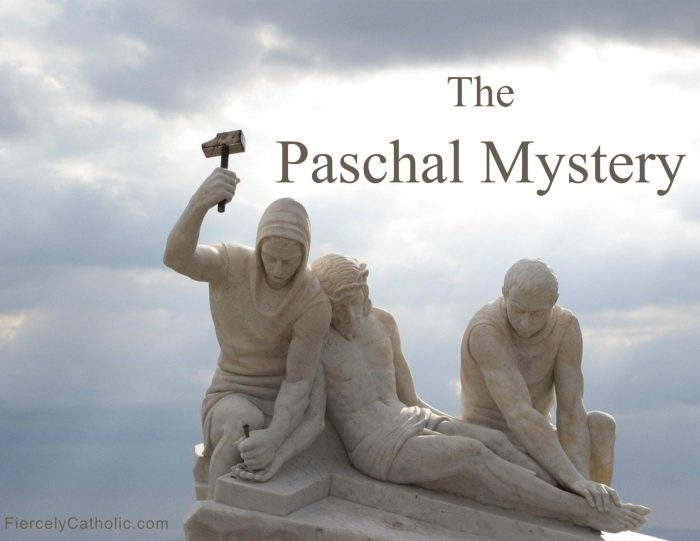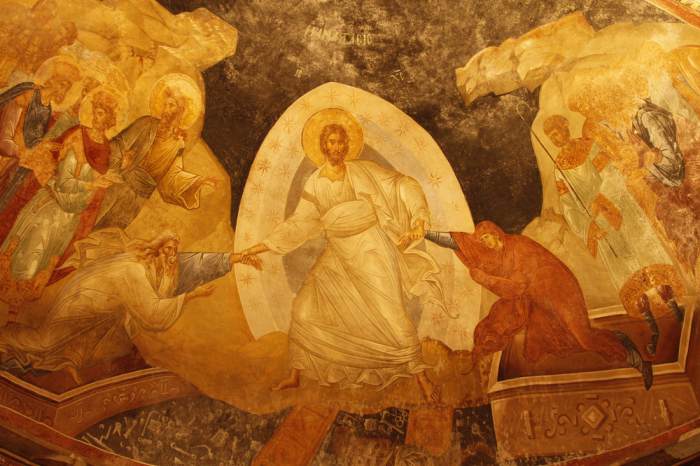The paschal mystery and the gospels – The Paschal Mystery, a cornerstone of Christianity, unfolds within the Gospels, offering a multifaceted account of Jesus’ death, resurrection, and subsequent events. This narrative, rich in symbolism and profound meaning, has shaped the beliefs and practices of Christians throughout history.
This exploration will delve into the significance of the Paschal Mystery, examining how the Gospels portray its key events and their impact on the lives of early Christians.
The Paschal Mystery in the Gospels
The Paschal Mystery is the central event in Christianity, commemorating the passion, death, and resurrection of Jesus Christ. It is a time of both sorrow and joy, as Christians remember the suffering of Christ on the cross and celebrate his victory over death.
The Gospels provide a detailed account of the events of the Paschal Mystery. They describe how Jesus was arrested, tried, and crucified. They also tell how he rose from the dead on the third day. The Gospels emphasize the importance of these events for salvation, as they show how Jesus conquered sin and death and made it possible for us to have eternal life.
The Significance of the Paschal Mystery
The Paschal Mystery is significant for a number of reasons. First, it reveals the love of God for humanity. God was willing to send his only Son to die for our sins. Second, it shows the power of God. Jesus was able to conquer death and rise from the dead.
Third, it gives us hope for eternal life. Jesus’ resurrection assures us that we too will be raised from the dead and live forever with God.
The Paschal Mystery in the Lives of the Early Christians
The Paschal Mystery had a profound impact on the lives of the early Christians. It gave them hope and strength in the face of persecution. It also inspired them to share the gospel with others. The Paschal Mystery continues to be a source of hope and inspiration for Christians today.
The Death and Resurrection of Jesus

The death and resurrection of Jesus Christ are central events in the Christian faith. They mark the culmination of his earthly ministry and the beginning of his heavenly reign. The Gospels provide detailed accounts of these events, which have profound significance for understanding the nature of salvation and the hope of eternal life.
The Events Leading Up to the Death of Jesus
The events leading up to the death of Jesus began with his triumphal entry into Jerusalem. This event fulfilled the prophecy of Zechariah 9:9, which foretold that the Messiah would come into Jerusalem riding on a donkey. Jesus’ entry into Jerusalem was met with great fanfare, as the people waved palm branches and shouted, “Hosanna to the Son of David!” (Matthew 21:9).
However, Jesus’ popularity was short-lived. The religious leaders in Jerusalem were jealous of his influence, and they began to plot against him. They accused him of blasphemy and treason, and they eventually convinced the Roman governor, Pontius Pilate, to condemn him to death.
The Significance of Jesus’ Death and Resurrection
The death of Jesus was a sacrificial act that atoned for the sins of humanity. Through his death, Jesus paid the penalty for our sins and made it possible for us to be reconciled to God. The resurrection of Jesus was a triumph over death and the grave.
It demonstrated that Jesus is the Son of God and that he has the power to conquer death.
The death and resurrection of Jesus are essential to the Christian faith. They are the foundation of our hope for salvation and eternal life. Through Jesus’ death, we are forgiven of our sins. Through his resurrection, we are given the promise of eternal life.
How the Gospels Portray the Resurrection of Jesus
The Gospels provide detailed accounts of the resurrection of Jesus. All four Gospels agree that Jesus rose from the dead on the third day after his crucifixion. However, there are some minor differences in the accounts of the resurrection.
In the Gospel of Matthew, Mary Magdalene and the other Mary went to the tomb early on Sunday morning and found that the stone had been rolled away and the tomb was empty. They were met by an angel who told them that Jesus had risen from the dead (Matthew 28:1-10).
In the Gospel of Mark, Mary Magdalene, Mary the mother of James, and Salome went to the tomb on Sunday morning and found that the stone had been rolled away. They entered the tomb and saw a young man sitting on the right side, dressed in a white robe.
The young man told them that Jesus had risen from the dead and that they should tell the disciples (Mark 16:1-8).
In the Gospel of Luke, Mary Magdalene, Joanna, and Mary the mother of James went to the tomb on Sunday morning and found that the stone had been rolled away. They entered the tomb but did not find the body of Jesus.
They were met by two angels who told them that Jesus had risen from the dead (Luke 24:1-12).
In the Gospel of John, Mary Magdalene went to the tomb early on Sunday morning and found that the stone had been rolled away. She ran to tell Peter and John, who came to the tomb and found it empty.
They saw the linen cloths that had been wrapped around Jesus’ body, but they did not see his body (John 20:1-10).
The Ascension and Pentecost

The Ascension and Pentecost are two pivotal events in the Paschal Mystery that mark the culmination of Jesus’ earthly ministry and the beginning of the Church’s mission.
The Ascension, The paschal mystery and the gospels
The Ascension of Jesus is recorded in all four Gospels (Matthew 28:16-20, Mark 16:19-20, Luke 24:50-53, John 20:17). It occurred forty days after Jesus’ resurrection, when he gathered his disciples on the Mount of Olives. As they watched, he ascended into heaven, a cloud enveloping him and obscuring him from their sight.
The Ascension signifies the end of Jesus’ physical presence on earth and his return to his Father in heaven. It also marks the beginning of his reign as the glorified Lord and the inauguration of the Church’s mission to proclaim the Gospel to all nations.
Pentecost
Pentecost, celebrated fifty days after Easter, marks the descent of the Holy Spirit upon the disciples gathered in Jerusalem (Acts 2:1-4). The Holy Spirit came upon them in the form of tongues of fire, empowering them with supernatural gifts and enabling them to speak in different languages.
Pentecost is considered the birthday of the Church, as it marks the beginning of the Church’s mission to spread the Gospel and make disciples of all nations. The Holy Spirit empowers the disciples to boldly proclaim the Gospel and to live out their faith in a transformed way.
The Paschal Mystery and the Church

The Paschal Mystery is the central event in the Christian faith. It is the death and resurrection of Jesus Christ, which brought about the salvation of the world. The Paschal Mystery is celebrated in the Church in a variety of ways, including the sacraments, the liturgy, and the preaching of the Word of God.The
sacraments are the outward signs of inward grace instituted by Christ. They are the means by which we receive the Paschal Mystery. The seven sacraments are Baptism, Confirmation, Eucharist, Penance, Anointing of the Sick, Holy Orders, and Matrimony.Each sacrament celebrates a different aspect of the Paschal Mystery.
Baptism celebrates our death to sin and resurrection to new life in Christ. Confirmation celebrates our being sealed with the Holy Spirit and strengthened for our Christian mission. Eucharist celebrates our sharing in the body and blood of Christ, which nourishes us for eternal life.
Penance celebrates our forgiveness of sins and our reconciliation with God. Anointing of the Sick celebrates our healing from physical and spiritual illness. Holy Orders celebrates our ordination to serve the Church. Matrimony celebrates our union with Christ and our commitment to each other.The
liturgy is the public worship of the Church. It is the means by which we celebrate the Paschal Mystery and enter into communion with God. The liturgy includes the Mass, the sacraments, and the other prayer services of the Church.The
preaching of the Word of God is the proclamation of the Gospel message. It is the means by which we learn about the Paschal Mystery and come to faith in Christ. The preaching of the Word of God takes place in the liturgy, in homilies, and in other settings.The
Paschal Mystery is a source of hope and renewal for the Church. It is the foundation of our faith and the source of our salvation. The Paschal Mystery reminds us that even in the midst of suffering and death, there is hope for new life.
Answers to Common Questions: The Paschal Mystery And The Gospels
What is the significance of the Paschal Mystery in Christianity?
The Paschal Mystery encompasses the central events of Jesus’ life, death, resurrection, and ascension, which are believed to bring salvation and redemption to humankind.
How do the Gospels portray the resurrection of Jesus?
The Gospels provide eyewitness accounts of Jesus’ resurrection, describing how he appeared to his disciples, spoke with them, and demonstrated his risen body.
What is the role of the Holy Spirit in the Paschal Mystery?
The Holy Spirit descends upon the disciples at Pentecost, empowering them to spread the Gospel and continue Jesus’ mission on earth.